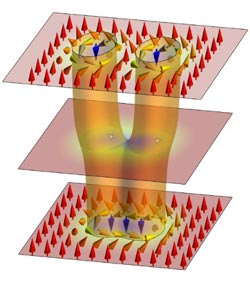Magnetic monopoles erase data

Depiction of the merging of two magnetic vortices, so-called skyrmions, in the magnetic structure of a material. The point at the which the vortices merge displays the properties of an emergent magnetic monopole. When the monopole moves along the direction of the vortices a skyrmion is created or destroyed (Picture: Ch. Schütte/University of Cologne)<br>
A physical particle postulated 80 years ago, could provide a decisive step toward the realization of novel, highly efficient data storage devices. Scientists at the Technische Universitaet Muenchen (TUM), the Technische Universitaet Dresden and the University of Cologne found that with magnetic monopoles in magnetic vortices, called skyrmions, information can be written and erased.
Iron filings strewn on a sheet of paper trace the field lines of a bar magnet below the paper, thereby showing the magnet's north and south poles. No matter how often it is split, the bar magnet always forms a north and a south pole. However, in the early 1930s physicist Paul A. M. Dirac postulated a particle that should, as the magnetic counterpart of the electron, possess only one of the two poles, and should carry just one magnetic elementary charge.
Looking for a simple way to study the magnetic vortices, researchers associated with TUM physicist Prof. Christian Pfleiderer collaborated with Prof. Lukas Eng's group at the Technische Universitaet Dresden, which has a magnetic force microscope. When they scanned the surface of the materials with this microscope, they not only observed the vortices for the first time, but also found that neighboring skyrmions merge with one another.
Computer simulations of Prof. Achim Rosch's group at Cologne, together with experiments at the research neutron source FRM II at TUM, showed that magnetic monopoles were at work here, drawing the vortices together like a zipper.
Compact and long-lived data storage
An important future application of the magnetic eddies could be extremely compact and long-lived storage media. Whereas one needs around a million atoms to store one bit in a modern hard disk, the smallest known skyrmions in magnetic materials consist of only 15 atoms.
At the same time moving such skyrmions requires 100,000 times less power than moving memory bits in devices based on conventional magnetic materials, in order to process information such a precisely controlled manner. Perhaps the most interesting characteristic of skyrmions, however, is that they are especially stable, like a knot in a string.
The magnetic vortex structures were discovered in 2009 through neutron scattering experiments on manganese-silicon in the research neutron source FRM II, conducted by a team around Christian Pfleiderer and Achim Rosch. Since then this area of research has attracted intense interest and made rapid progress worldwide. “Whereas initially the experiments required extremely low temperatures, today we also know materials in which skyrmions exist at room temperature,” says Christian Pfleiderer, Professor for Magnetic Materials at the Technische Universitaet Muenchen.
“With the magnetic force microscopy, we finally have a method at hand that allows us for the first time to observe skyrmions in systems that are relevant for applications. This is a decisive step in the direction of a real technical use.”
The work was funded by the European Research Council, the German Research Foundation, (DFG), and the Australian Research Council, as well as the TUM Graduate School and the Bonn-Cologne Graduate School.
Publication:
Unwinding of a Skyrmion Lattice by Magnetic Monopoles,
P. Milde, D. Köhler, J. Seidel, L. M. Eng, A. Bauer, A. Chacon, J. Kindervater, S. Mühlbauer, C. Pfleiderer, S. Buhrandt, C. Schütte, A. Rosch,
Science, Advanced online publication, 31 May 2013, DOI: after end of embargo
Contact:
Prof. Dr. Christian Pfleiderer
Technische Universität München
Physik-Department
T: +49.89.289-14720
E: christian.pfleiderer@frm2.tum.de
Media Contact
More Information:
http://www.e21.ph.tum.deAll latest news from the category: Physics and Astronomy
This area deals with the fundamental laws and building blocks of nature and how they interact, the properties and the behavior of matter, and research into space and time and their structures.
innovations-report provides in-depth reports and articles on subjects such as astrophysics, laser technologies, nuclear, quantum, particle and solid-state physics, nanotechnologies, planetary research and findings (Mars, Venus) and developments related to the Hubble Telescope.
Newest articles

Combatting disruptive ‘noise’ in quantum communication
In a significant milestone for quantum communication technology, an experiment has demonstrated how networks can be leveraged to combat disruptive ‘noise’ in quantum communications. The international effort led by researchers…

Stretchable quantum dot display
Intrinsically stretchable quantum dot-based light-emitting diodes achieved record-breaking performance. A team of South Korean scientists led by Professor KIM Dae-Hyeong of the Center for Nanoparticle Research within the Institute for…

Internet can achieve quantum speed with light saved as sound
Researchers at the University of Copenhagen’s Niels Bohr Institute have developed a new way to create quantum memory: A small drum can store data sent with light in its sonic…





















